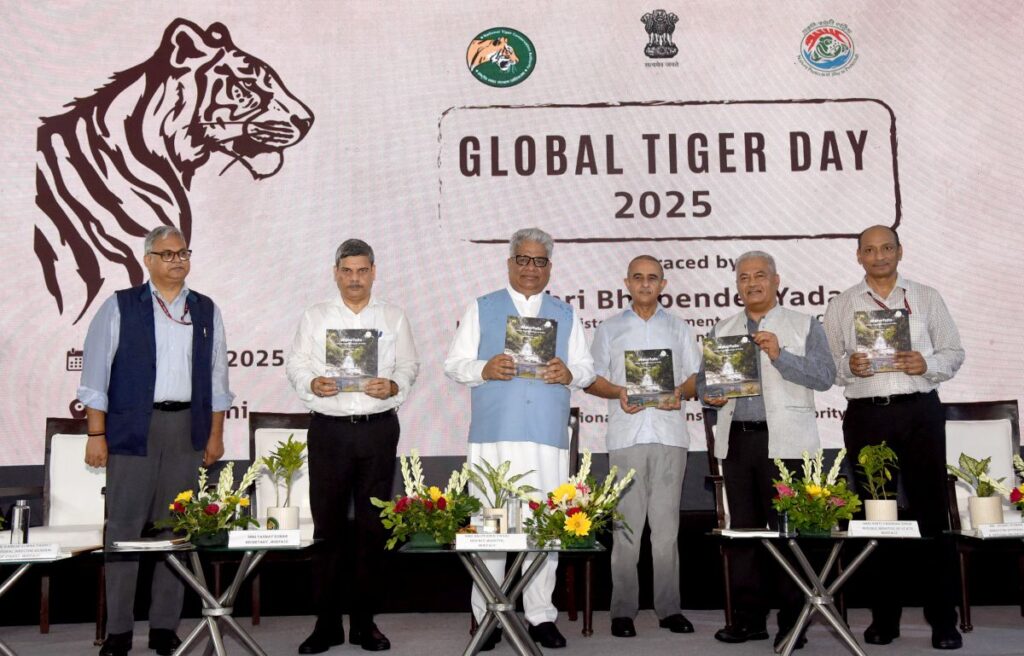
Union Minister for Environment, Forest and Climate Change, Shri Bhupender Yadav, led the Global Tiger Day 2025 celebrations at the National Zoological Park, New Delhi, reaffirming India’s unwavering commitment to wildlife conservation and ecological sustainability.
Addressing the gathering, Shri Yadav underscored the vital role of ecological balance and conservation awareness, especially among children. Commending schools and teachers for sensitizing young minds, he stated, “Under Prime Minister Shri Narendra Modi’s leadership, the number of tiger reserves in India has increased from 46 in 2014 to 58, reflecting our strong dedication to protecting our national animal.”
A major highlight of the day was the announcement of a nationwide tree plantation drive across all 58 tiger reserves, with over one lakh saplings to be planted — one of the world’s largest such campaigns. Shri Yadav also launched the ‘Ek Ped Maa Ke Naam’ initiative, encouraging citizens to plant a tree in their mother’s name as a tribute to both their mothers and Mother Earth.

The Minister highlighted India’s leadership in global conservation through the International Big Cat Alliance (IBCA), which aims to protect the seven big cat species worldwide. “So far, 24 countries have joined this initiative, with the IBCA headquarters to be established in India,” he informed.
Calling for environmental stewardship under Mission LiFE, Shri Yadav urged the youth to embody values of patience, humility, and determination. “Even the tiger, the most powerful of creatures, teaches us humility. True progress lies in harmony with nature,” he said.
Union Minister of State (MoEFCC), Shri Kirti Vardhan Singh, along with key stakeholders including forest officials, conservationists, NGOs, students, and community members, also attended the event — highlighting a collective, multi-stakeholder approach to tiger conservation.
A unique attraction was the Eco-Shop Exhibition, showcasing community-based sustainable products from various tiger reserves, particularly the Western Ghats and Southern landscapes. The exhibition illustrated how local enterprise models contribute to conservation by supporting forest-dependent livelihoods and reducing human-wildlife conflict.
Shri Yadav also virtually inaugurated tree plantation drives across all tiger reserves, with each reserve planting 2,000 indigenous saplings in degraded areas. In addition, he inaugurated three forest nurseries in the Aravalli landscape to promote native species and ecological restoration.
Further, the Minister launched the ‘Plastic-Free Tiger Reserves’ campaign, aimed at phasing out single-use plastics in protected areas.
The event also saw the release of four significant publications under the National Tiger Conservation Authority (NTCA):
- Status of Small Cats in the Tiger Landscape of India
- STRIPES Magazine – Global Tiger Day Special Edition
- Waterfalls of Tiger Reserves in India
- Water Bodies inside Tiger Reserves of India
In a special segment, NTCA Awards were presented across seven categories including anti-poaching efforts, wildlife monitoring, eco-development, and posthumous recognition for forest staff who lost their lives in the line of duty.
The Global Tiger Day 2025 celebrations reflected India’s integrated approach to conservation — blending policy action, grassroots engagement, and global collaboration to ensure the survival and thriving of tigers in the wild.






